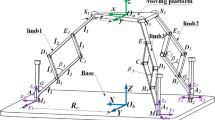Abstract
Friction stir welding (FSW) has recently emerged as a solid-joining technology for high-strength aluminum alloys and light metal welding. The large axial force to be maintained between the welding tool and workpiece is the primary requirement of FSW process, which has also been a great obstacle to the design and application of FSW in manufacturing. Further complicating the issue is the need to perform FSW over three-dimensional contours, which requires a mechanism dexterous enough to set the stir pin used in welding to track a predefined trajectory with prescribed poses. Apart from the position specification, the design of a dexterous mechanism to pose the orientation of stir pin is a great challenge. This paper proposed the application of 3-PRS (P, R, and S standing for prismatic, revolute, and spherical joint, respectively) parallel mechanism as a welding tool head and employed it to form a five-axis welding machine tool for FSW. In order to accommodate the orientation capability requirements, the kinematic feature has been analyzed. With the dimensionless treatment of the Jacobian matrix of 3-PRS manipulator, a global condition index is proposed to estimate the kinematic dexterity in the whole orientation workspace. Finally, by means of an optimal design method and performance atlas, optimal designs of the 3-PRS parallel mechanism is carried out. A preferable set of optimized geometric parameters are obtained to achieve a compact and dexterous design, and the optimization results are used in development of a prototype machine for FSW.
Similar content being viewed by others
References
Thomas WM, Nicholas ED, Needham JC, Church MG, Templesmith P, Dawes CJ (1991) Simulation of friction stir welding. Ind Robot Int J 37:36–50, Number 1 2010
Kallee SW (2007) Worldwide applications of friction stir welding. TWI Ltd.
Soron M, Kalaykov I (2006) A robot prototype for friction stir welding. IEEE Conference on Robotics, Automation and Mechatronics
Smith CB (2000) Robotic friction stir welding using a standard industrial robot. Second Friction Stir Welding International Symposium, Gothenburg, Sweden
Von Strombeck A, Schilling C, Dos Santos JF (2001) Robotic friction stir welding—tool, technology and applications. Biuletyn Inst Spawalnictwa (Poland) 45(6):49–57
Longhurst W, Strauss A et al (2010) Torque control of friction stir welding for manufacturing and automation. Int J Adv Manuf Technol 51(9):905–913
Backer JD, Verheyden B (2009) Robotic friction stir welding for automotive and aviation applications. Master thesis
Fernandez AJS, Jimenez VC, Olazabal MG (2002) Kinematical system for a movable platform of a machine. European patent no. EP1245349(A1)
Wahl J (2000) Articulated tool head. WIPO patent no. WO 00/25976
Lung-Wen T, Walsh GC et al (1996) Kinematics of a novel three DOF translational platform. IEEE International Conference on Robotics and Automation Proceedings
Tsai M-S, Shiau T-N et al (2003) Direct kinematic analysis of a 3-PRS parallel mechanism. Mech Mach Theory 38(1):71–83
Joshi SA, Tsai L-W (2002) Jacobian analysis of limited-DOF parallel manipulators. J Mech Des 124(2):254
Briot S, Bonev IA (2008) Singularity analysis of zero-torsion parallel mechanisms. IROS 2008. IEEE/RSJ International Conference on Intelligent Robots and Systems
Huang P, Wang J et al (2011) Identification of structure errors of 3-PRS-XY mechanism with regularization method. Mech Mach Theory 46(7):927–944
Xi F, Han W et al (2001) Development of a sliding-leg tripod as an add-on device for manufacturing. Robotica 19(03):285–294
Chen SL, Chang TH et al (2002) Post-processor development of a hybrid TRR-XY parallel kinematic machine tool. Int J Adv Manuf Technol 20(4):259–269
Merlet JP (2006) Jacobian, manipulability, condition number, and accuracy of parallel robots. J Mech Des 128(1):199–206
Liu X-J, Wang J (2007) A new methodology for optimal kinematic design of parallel mechanisms. Mech Mach Theory 42(9):1210–1224
Li Y, Xu Q (2007) Kinematic analysis of a 3-PRS parallel manipulator. Robot Comput Integr Manuf 23(4):395–408
Angeles J (2003) Fundamentals of robotic mechanical systems—theory, methods and algorithms. New York: Springer-Verlag
Guilin Y, Weihai ELC (2004) A differential geometry approach for the workspace analysis of spherical parallel manipulators. Proceedings of the 11th World Congress in Mechanism and Machine Science
Bonev IA (2002) Geometric analysis of parallel mechanisms. Laval University, Quebec
Rao ABK, Rao PVM, Saha SK (2005) Dimensional design of optimal workspace and dexterity. IEEE Trans Robot 21(3):444–9
Chablat D, Wenger P (2003) Architecture optimization of a 3-DOF translational parallel mechanism for machining applications, the Orthoglide. IEEE Trans Robot Autom 19(3):403–10
Kim S-G, Ryu J (2003) New dimensionally homogeneous Jacobian matrix formulation by three end-effector points for optimal design of parallel manipulators. IEEE Trans Robot Autom 19(4):731–7
Gosselin CM (1992) The optimum design of robotic manipulators using dexterity indices. J Robot Auton Syst 9(4):213–26
Gosselin C. Kinematic analysis optimization and programming of parallel robotic manipulators. Ph.D. Thesis, McGill University, Montreal, 15 June 1988
Liu X-J, Wang J, Kim J (2006) Determination of the link lengths for a spatial 3-DoF parallel manipulator. ASME J Mech Des 128:365–373
Author information
Authors and Affiliations
Corresponding author
Rights and permissions
About this article
Cite this article
Shi, J., Wang, Y., Zhang, G. et al. Optimal design of 3-DOF PKM module for friction stir welding. Int J Adv Manuf Technol 66, 1879–1889 (2013). https://doi.org/10.1007/s00170-012-4467-7
Received:
Accepted:
Published:
Issue Date:
DOI: https://doi.org/10.1007/s00170-012-4467-7



